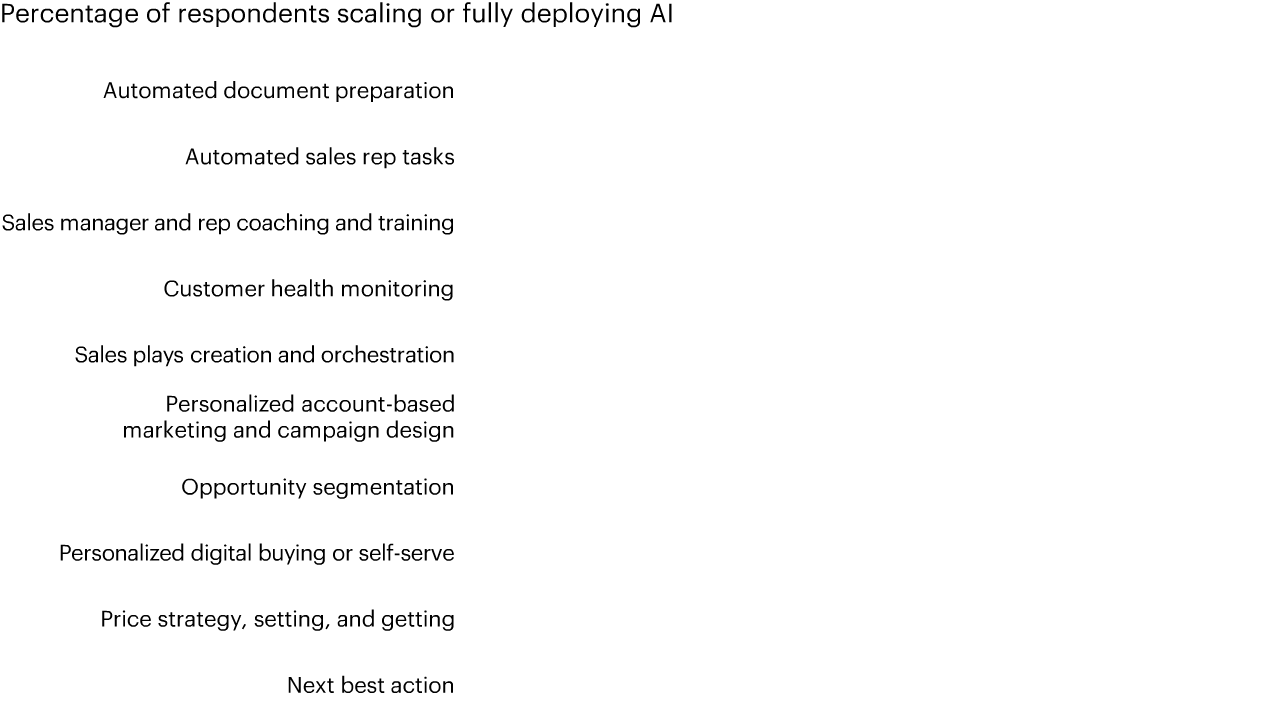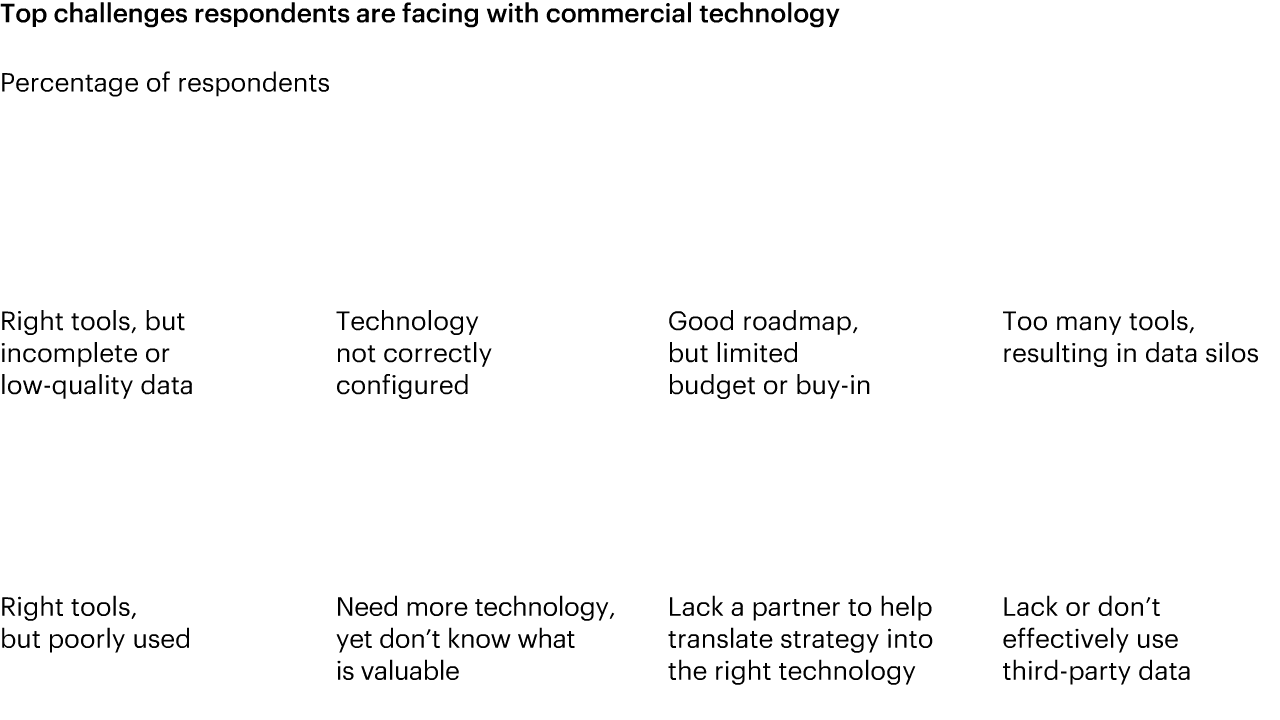Commercial Excellence Agenda

Executive Summary
- High-growth B2B firms gain significant efficiency and productivity boosts by scaling AI beyond pilots into core operations.
- There is no single superior use case as different companies get value from different use cases.
- However, many organizations still struggle to scale up pilots into sustainable, value-generating deployments.
- Winners distinguish themselves by developing the right tech stack and data foundation, strategically choosing use cases, integrating AI with other processes, and cocreating with the front line.
This article is part of Bain's 2025 Commercial Excellence and Revenue Growth Agenda.
Across most business-to-business (B2B) industries during 2024, companies were in the early stages of getting to know generative artificial intelligence (AI). Now more of them are starting to reap real value. More than 90% of about 1,300 commercial executives surveyed by Bain have scaled up at least one AI use case. Those that have moved beyond pilots and superficial applications, expanding the number of use cases and integrating AI into core processes and customer interfaces, realize the greatest value.
Reaping value from an array of use cases
There is no single winning application as industries invest in different AI use cases depending on their unique bottlenecks. B2B companies continue to invest in a wide range of use cases, from knowledge management assistants that speed up customization of materials for sales reps, to identifying purchase intent among a long tail of buyers, to optimizing contracts. Some IT services companies, for example, use AI to customize sales collateral and their responses to requests for proposals by stitching together critical technology capabilities and success stories from existing repositories. This can speed up the process and showcase the applicable strengths and successes most relevant to particular customers.
Nearly all companies have begun to deploy AI, the survey finds, with 62% of respondents saying they have scaled up to more than two use cases last year, and 30% scaling up to one to two use cases (see Figures 1 and 2). As a result, many are now seeing value from AI. AI deployment met expectations for more than 90% of respondents that have scaled up their use cases, and it has exceeded expectations for 57%.


Note: Rankings are tied when respondents chose the same number of use cases for a given use case
Source: Bain Commercial Excellence Survey, January 2025 (n=1,263)Even within the top use cases, the specifics vary by industry. Consider automated document preparation. We’ve seen AI applied to preparing requests for proposals in construction and manufacturing, while technology companies frequently use the technology to tailor sales materials for specific clients.
Similarly, automating sales rep tasks can range from simply helping reps enter the right details into their customer relationship management systems after each interaction to fully autonomous AI business development reps handling inbound or even outbound communications for initial sales stages. The latter typically applies to firms with faster sales and lower ticket prices.
Value from AI tends to be concentrated among the revenue growth winners. (We define winners as companies that ranked above the upper quartile of revenue growth for their sector and region in 2024 and that demonstrated positive gross margin growth. Laggards are companies that ranked below the lower quartile of revenue growth for their industry and region in 2024.)
Growth winners deploy more use cases—an average of 4.5 vs. just 3.3 for laggards. These winners are realizing almost 2 times greater cost efficiencies than laggards for any given use case. They accomplish that partly through investment: Winners allocate more resources to sales and marketing technologies broadly, both in absolute terms and as a proportion of their overall sales and marketing budget (see Figure 3).
Why many firms still struggle
For all the benefits B2B companies have seen, some AI programs are falling short. Roughly a quarter of respondents’ sales and marketing AI pilots have failed, and among the AI use cases in pilot phase, roughly one-fifth are not meeting expectations. About 12% of respondents said that their AI deployment has not met expectations. Growth laggards in particular struggle to realize value—for instance, 35% of laggards that completed pilots on automating sales representative tasks are no longer pursuing this capability.
Slightly more than half of commercial organizations acknowledge that they have not set up adequate technology and data foundations to optimize AI. Heading the list of challenges: dealing with incomplete or low-quality data, and technology that’s not correctly configured (see Figure 4).
Incomplete or low-quality data has several symptoms and root causes, including the inability to create a unified customer profile. Low-quality data usually stems from poor data integration among different systems, resulting in duplicate or disconnected records. As for poorly configured technology, this surfaces when organizations have bought many different tools but fail to connect them, rendering the technology less useful to end users.


Winners’ best practices
To make real progress requires a systematic, measurable approach to AI deployment. Besides the technology and data foundations mentioned earlier, winners invest in managing the changes required to make AI effective. They secure senior executive sponsorship. They adhere to proven best practices, such as creating a robust business case, performing a buy vs. build evaluation, and investing in training. In fact, the winners adhere to three best practices on average vs. two for laggards. And those companies following four or more best practices realize 12% cost efficiency vs. just 5% for companies following none of the practices.
Using AI at scale has become table stakes for B2B companies, the survey analysis suggests. For the next few years, their growth prospects hinge in part on deploying the technology to operate more efficiently and deliver better products and service to customers.
Read our 2025 Commercial Excellence and Revenue Growth Agenda
Explore the Report